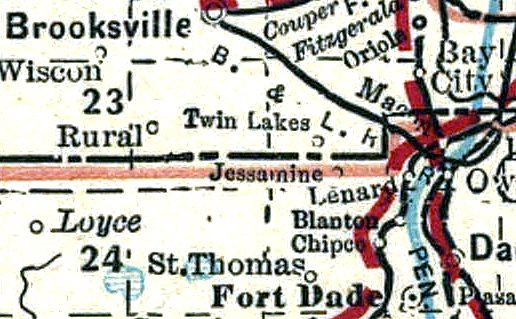HISTORY OF PASCO COUNTYJessamine This page was last revised on June 6, 2017. 1887. Walter N. Pike and William J. Ellsworth arrive and establish a seed and plant business called Jessamine Gardens. A post office was established at Jessamine in 1888. Aug. 13, 1901. The Tampa Morning Tribune reports, “The famous Jessamine gardens of Pasco county will exhibit at the State Fair.” Jan. 1, 1913. The Tampa Morning Tribune reports, “The Tampa Bay Land Company is very busy at this season driving prospective buyers over its lands in autos. It has sold fifteen hundred acres in the vicinity of Blanton and the Jessamine Grove to Germans from Minnesota, who expect to soon settle on the tract with people of their own nationality from the north.” Jan. 15, 1913. The Tampa Morning Tribune reports, “The water tower at the Jessamine groves is a marvel of beauty. It is completely covered with brilliant flame flowers. It is worth an auto trip from Tampa just to see it. Auto party after auto party visit the groves and are charmed with the gorgeous display.” March 6, 1914. H. M. Platt of New York, who had spent the winters at his home at Jessamine for 17 years, dies at 78. His daughter, Mrs. W. J. Ellsworth of the Jessamine Groves, lived with him. Dec. 24, 1914. The Tampa Morning Tribune reports, “C. J. Nathe, Messrs. Blocker and Dowling and Jessamine Groves are all heavy shippers of the kumquat fruit. The Jessamine Groves report shipments of 250 crates of ‘gold oranges’ last week.” Feb. 7, 1919. The Tampa Morning Tribune reports, “The fruit growers here are shipping a car of fruit every day from the Blanton packing house. They bought the fruit of the Jessamine grove. There has already been shipped over 40,000 boxes of fruit from Blanton this season. The Jessamine Grove’s Nurseries are very busy shipping citrus fruit trees, roses and ornamental plants from their large nurseries near Blanton.” Jessamine Community (1976)This article is taken from East Pasco’s Heritage. By WILMA ELLSWORTH Communities come into being and pass out of existence, sometimes leaving no trace, sometimes only the name of the first settler. One east Pasco community was left with a lovely name which has often been misspelled because its source has been forgotten. In 1887 the new Pasco County received two idealistic young business men, Walter N. Pike and William J. Ellsworth, who were intent on starting a seed and plant business in the land of flowers. They set up housekeeping with their brides in an old cabin on the edge of a small lake, about five miles southwest of Trilby. With strong backs hired from the settlement near the county line, they began the clearing of the pine and hammock acres—a slow process done with ax, mattock, saw, and much sweat of the brow. During this deforesting period, young Pike and Ellsworth were so impressed with the beauty and delicate fragrance of a certain wild flowering vine that they named their firm “Jessamine Gardens,” and their community “Jessamine.” Years later, in the wake of severe freezes, mail thefts, and financial panic widespread, they developed citrus under the name “Jessamine Groves,” thus continuing to emphasize the community name. In the early days freight was hauled from Trilby. When the railroad was extended to St. Petersburg, Blanton was made a way station and became a receiving point. I recall hearing my uncle mention that some small shipments were brought up the mile-and-a-quarter from that depot by wheelbarrow. Because of business needs, Pike and Ellsworth got permission to operate a postoffice at Jessamine. This served a number of families within a range of two or three miles. The mail was brought by horseback from Trilby and outgoing mail picked up. The same rider also served the Blanton area where the industry was a good-sized sawmill. Jessamine postoffice continued until about 1912, when the Rural Free Delivery reached out to individual families. The first postoffice was contained in the front of the Jessamine Gardens business house, where the seeds and bulbs were readied for shipping. With its lobby the postoffice took up a space about twenty by twenty-eight feet, completely sheltered within the building. Later, when the house was converted into a dwelling, a small unit scarcely eight by eight feet, partitioned through the center, provided an entry for customers and also a panel of private boxes, with a General Delivery and stamp window. |
